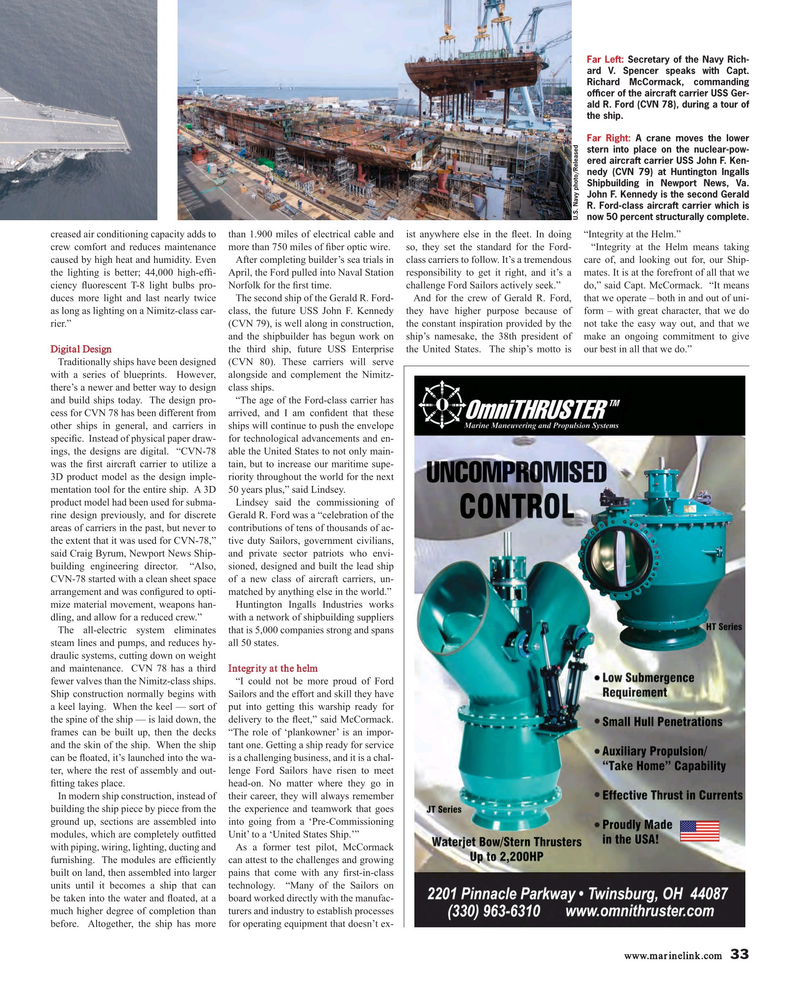
Page 33: of Maritime Reporter Magazine (September 2017)
U.S. Navy Quarterly
Read this page in Pdf, Flash or Html5 edition of September 2017 Maritime Reporter Magazine
Far Left: Secretary of the Navy Rich- ard V. Spencer speaks with Capt.
Richard McCormack, commanding of? cer of the aircraft carrier USS Ger- ald R. Ford (CVN 78), during a tour of the ship.
Far Right: A crane moves the lower stern into place on the nuclear-pow- ered aircraft carrier USS John F. Ken- nedy (CVN 79) at Huntington Ingalls
Shipbuilding in Newport News, Va.
John F. Kennedy is the second Gerald
R. Ford-class aircraft carrier which is
U.S. Navy photo/Released now 50 percent structurally complete. creased air conditioning capacity adds to than 1.900 miles of electrical cable and ist anywhere else in the ? eet. In doing “Integrity at the Helm.” crew comfort and reduces maintenance more than 750 miles of ? ber optic wire. so, they set the standard for the Ford- “Integrity at the Helm means taking caused by high heat and humidity. Even After completing builder’s sea trials in class carriers to follow. It’s a tremendous care of, and looking out for, our Ship- the lighting is better; 44,000 high-ef? - April, the Ford pulled into Naval Station responsibility to get it right, and it’s a mates. It is at the forefront of all that we ciency ? uorescent T-8 light bulbs pro- Norfolk for the ? rst time. challenge Ford Sailors actively seek.” do,” said Capt. McCormack. “It means duces more light and last nearly twice The second ship of the Gerald R. Ford- And for the crew of Gerald R. Ford, that we operate – both in and out of uni- as long as lighting on a Nimitz-class car- class, the future USS John F. Kennedy they have higher purpose because of form – with great character, that we do rier.” (CVN 79), is well along in construction, the constant inspiration provided by the not take the easy way out, and that we and the shipbuilder has begun work on ship’s namesake, the 38th president of make an ongoing commitment to give
Digital Design the third ship, future USS Enterprise the United States. The ship’s motto is our best in all that we do.”
Traditionally ships have been designed (CVN 80). These carriers will serve with a series of blueprints. However, alongside and complement the Nimitz- there’s a newer and better way to design class ships.
and build ships today. The design pro- “The age of the Ford-class carrier has cess for CVN 78 has been different from arrived, and I am con? dent that these other ships in general, and carriers in ships will continue to push the envelope speci? c. Instead of physical paper draw- for technological advancements and en- ings, the designs are digital. “CVN-78 able the United States to not only main- was the ? rst aircraft carrier to utilize a tain, but to increase our maritime supe- 3D product model as the design imple- riority throughout the world for the next mentation tool for the entire ship. A 3D 50 years plus,” said Lindsey.
product model had been used for subma- Lindsey said the commissioning of rine design previously, and for discrete Gerald R. Ford was a “celebration of the areas of carriers in the past, but never to contributions of tens of thousands of ac- the extent that it was used for CVN-78,” tive duty Sailors, government civilians, said Craig Byrum, Newport News Ship- and private sector patriots who envi- building engineering director. “Also, sioned, designed and built the lead ship
CVN-78 started with a clean sheet space of a new class of aircraft carriers, un- arrangement and was con? gured to opti- matched by anything else in the world.” mize material movement, weapons han- Huntington Ingalls Industries works dling, and allow for a reduced crew.” with a network of shipbuilding suppliers
The all-electric system eliminates that is 5,000 companies strong and spans steam lines and pumps, and reduces hy- all 50 states. draulic systems, cutting down on weight and maintenance. CVN 78 has a third Integrity at the helm fewer valves than the Nimitz-class ships. “I could not be more proud of Ford
Ship construction normally begins with Sailors and the effort and skill they have a keel laying. When the keel — sort of put into getting this warship ready for the spine of the ship — is laid down, the delivery to the ? eet,” said McCormack. frames can be built up, then the decks “The role of ‘plankowner’ is an impor- and the skin of the ship. When the ship tant one. Getting a ship ready for service can be ? oated, it’s launched into the wa- is a challenging business, and it is a chal- ter, where the rest of assembly and out- lenge Ford Sailors have risen to meet ? tting takes place. head-on. No matter where they go in
In modern ship construction, instead of their career, they will always remember building the ship piece by piece from the the experience and teamwork that goes ground up, sections are assembled into into going from a ‘Pre-Commissioning modules, which are completely out? tted Unit’ to a ‘United States Ship.’” with piping, wiring, lighting, ducting and As a former test pilot, McCormack furnishing. The modules are ef? ciently can attest to the challenges and growing built on land, then assembled into larger pains that come with any ? rst-in-class units until it becomes a ship that can technology. “Many of the Sailors on be taken into the water and ? oated, at a board worked directly with the manufac- much higher degree of completion than turers and industry to establish processes before. Altogether, the ship has more for operating equipment that doesn’t ex- www.marinelink.com 33
MR #9 (26-33).indd 33 MR #9 (26-33).indd 33 9/6/2017 10:51:29 AM9/6/2017 10:51:29 AM

 32
32

 34
34
